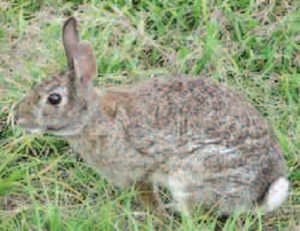SCORES & OUTDOORS: Eastern cottontail numbers affect lynx population
 SCORES & OUTDOORS
SCORES & OUTDOORS
by Roland D. Hallee
Walking through the woods following a snowfall can show evidence of many wildlife tracks. One that I saw recently was that of the Eastern Cottontail rabbit.
The Eastern Cottontail, Salvilagus floridanus, is actually a New World cottontail rabbit, a member of the family Leporidae. It is one of the most common rabbit species in North America.
Here in Maine, its numbers has a profound affect on the Canada lynx population. The survival rate of the lynx is dependent on a healthy cottontail population.
The Eastern Cottontail is chunky red-brown or gray-brown in appearance with large hind feet, long ears and a short fluffy white tail. Its underside fur is white. There is a rusty patch on the tail.

Eastern cottontail
Its appearance differs from that of a hare in that it has a brownish-gray coloring around the head and neck. The body is lighter color with a white underside on the tail. It has large brown eyes to see and large ears to listen for danger. In the winter, its coloring is more gray than brown. The kittens develop the same coloring after a few weeks, but they also have a white blaze that goes down their forehead. This marking eventually disappears. The average adult weighs between 2-4 pounds. However, the female tends to be heavier.
They can be found in the eastern and southwestern United States, southern Canada, eastern Mexico all the way down to South America. Originally, it was not found in New England, but it has been introduced here and now competes for habitat with the native New England cottontail.
The rabbits are active at night, and do not hibernate in winter. Predators include hawks, owls, coyotes, wolves and the aforementioned lynx. On farms and in gardens, they are considered pests and are often trapped or shot to protect plants.
Mating occurs from February to September. Males will mate with more than one female. Females have 2 to 4 large litters of up to nine young in a year. After the female has given birth to her offspring, she can mate again immediately thereafter. The kittens are weaned after three weeks and leave the nest after seven weeks. The kittens then reach mating age after three months.
The Eastern cottontail is a very territorial animal. When running, it can jump from 15 feet, which can aid in avoiding predators. When chased, it runs in a zigzag pattern so the animal chasing it will lose its scent, making the rabbit harder to follow. They can run up to 18 miles per hour. The cottontail prefers an area where it can hide quickly but be out in the open. Forests, swamps, thickets, bushes or open areas where it can dig a burrow are optimal habitation sites for this species.
I had one appear in my backyard a few years ago and seemed to have settled in very well. It apparently found a buffet of clover that grows wild around my garden area. It stayed around for about a week. Unfortunately, although it seemed content where it was, the constant attempt of neighborhood kids to capture it led it to run off in a desperate escape attempt on several occasions. I found it dead one Sunday morning, apparently the victim of a road kill collision with a car.
Responsible journalism is hard work!
It is also expensive!
If you enjoy reading The Town Line and the good news we bring you each week, would you consider a donation to help us continue the work we’re doing?
The Town Line is a 501(c)(3) nonprofit private foundation, and all donations are tax deductible under the Internal Revenue Service code.
To help, please visit our online donation page or mail a check payable to The Town Line, PO Box 89, South China, ME 04358. Your contribution is appreciated!


Leave a Reply
Want to join the discussion?Feel free to contribute!